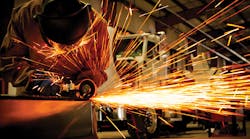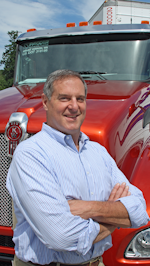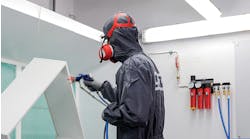Manager’s guide to health and safety in the vehicle collision repair industry
Those involved in operations that repair and refinish automobiles, trucks and equipment are subjected to a multitude of physical and chemical hazards. A hazard is a source or situation with a potential for harm – in terms of human injury or ill health or a combination of these.
These workers are potentially exposed to a range of harmful substances while prepping and painting vehicles. Among them:
- Chemical hazards, including:
+ Volatile organic compounds emitted solvents, cleaners, fillers, paints, etc., which include a variety of chemicals, some of which may have short- and long-term adverse health effects.
+ Toxic chemicals.
+ Heavy metals.
+ Sanding dusts.
+ Metal fumes from welding and cutting.
- Physical hazards from cutting and sanding tools, welding, noise, repetitive stress and other ergonomic injuries, lifting and/or slippery and greasy walking surfaces.
A safe and healthy workplace is a more productive workplace. Moreover, both vehicle collision repair shops, and their employees, benefit when effective health and safety practices are created, implemented and maintained. This includes installing and maintaining control equipment and using safer paints and solvents.
All this works to:
- Reduce the risk of accidents. (Risk is a combination of the likelihood and severity or consequence of a specific hazardous event.)
- Save money and avoid fines.
- Improve employee morale and enhance goodwill.
- Lower turnover.
Both employers and workers have roles in eliminating potential hazards to keep their workplace safe.
Safety and health legislation “places a general duty on employers, so far as is reasonably practicable, to ensure the health, safety and welfare at work of their employees and others who may be affected by their work activities,” note officials with 3M (www.3m.com) Business Solutions. In addition, legislation requires that employees “take reasonable care of their own safety and that of other people who may be affected by their actions,” and are also “required to cooperate with their employer to enable legal obligations to be met.”
RISK ASSESSMENT
To help prevent injury and illness in vehicle collision repair shops, it is wise to conduct a risk assessment, health and safety officials say. Basically, this involves taking a thorough look at a workplace to identify those things, situations, processes, etc., that may cause harm, particularly to people.
The purpose is to remove a hazard, or reduce the level of its risk, by adding precautions or control measures, as necessary, to create a safer and healthier workplace.
The three basics steps to risk assessment are:
1. Identify hazards.
2. Analyze or evaluate the risk associated with that hazard.
3. Decide upon appropriate ways to eliminate or control the hazard.
It is useful to rank and prioritize risks, say the officials. One way to do this is to categorize by the likelihood of harm and the severity of harm.
One way to accomplish this is to use a method established by the British Standards Organization:
RISK ASSESSMENT ESTIMATOR
|
Likelihood of Harm |
Severity of Harm |
||
|
Slight Harm |
Moderate Harm |
Extreme Harm |
|
|
Very unlikely |
Very low risk |
Very low risk |
High risk |
|
Unlikely |
Very low risk |
Medium risk |
Very high risk |
|
Likely |
Low risk |
High risk |
Very high risk |
|
Very likely |
Low risk |
Very high risk |
Very high risk |
The Organization uses these definitions for likelihood of harm for a typical occurrence:
- Very likely – Typically experienced at least once every six months by an individual.
- Likely – Typically experienced at least once every five years by an individual.
- Fairly likely – Typically experienced at least once every 10 years by an individual.
- Unlikely – Typically experienced at least once during the working lifetime of an individual.
- Very unlikely – Less than a 1 percent chance of being experienced by an individual during their working lifetime.
TOLERANCE CRITERIA
|
Category of Risk |
Evaluation of Tolerability |
|
Very low risk |
Acceptable. No further action necessary. |
|
Low risk |
No additional controls are required unless they can be implemented at very low cost in terms of time, money and effort. |
|
Medium risk |
Consideration should be given to lowering the risk to an acceptable level, but the costs of additional risk reduction measures should be taken into account. |
|
High risk |
Substantial efforts should be made to reduce the risk to an acceptable level. Risk reduction measures should be implemented urgently. |
|
Very high risk |
These risks are unacceptable. Substantial improvements are necessary to reduce the risk to an acceptable level. The activity should be halted until risk controls are implemented that reduces the risk so that it is no longer very high. |
REVIEW
It is best to have risk assessments done by a competent team of individuals who have a good working knowledge of the workplace and who work with the processes under review.
Furthermore, it is important to review the risk assessment on a regular basis to determine if any changes have occurred within the workplace and if the risk control methods remain effective, health and safety officials advise. Any of the following could be a cause for a review:
- Changes in the work process or flow.
- Changes or additions to tools, equipment, machinery, etc., including their locations or the way they are used.
- Moving to a new facility or work area.
- Introduction of new chemicals or substances.
PPE
Shops need to provide personal protective equipment (PPE), Occupational Safety and Health Administration (OSHA) officials say. The PPE needs to be suitable for the work being done and worn as intended.
Employers and employees must understand the equipment's purpose and its limitations, they note. PPE clothing and equipment should be of safe design and construction and be maintained in a clean and reliable condition.
If PPE does not fit properly, it can make the difference between a worker being safely covered or dangerously exposed.
Wearing poorly maintained or malfunctioning PPE could be more dangerous than not wearing any form of protection at all, say OSHA (www.osha.gov) officials. Workers gain a false sense of security and think they are protected when, in reality, they are not.
David A. Kolman is editor of Fleet Maintenance, the only publication that provides a wide-ranging curriculum and best practices to enable readers to keep vehicles operating with greatest efficiency and minimal downtime, and improve their personal performance. An award-winning journalist, he has been actively involved in the North American transportation industry for more than 30 years.




